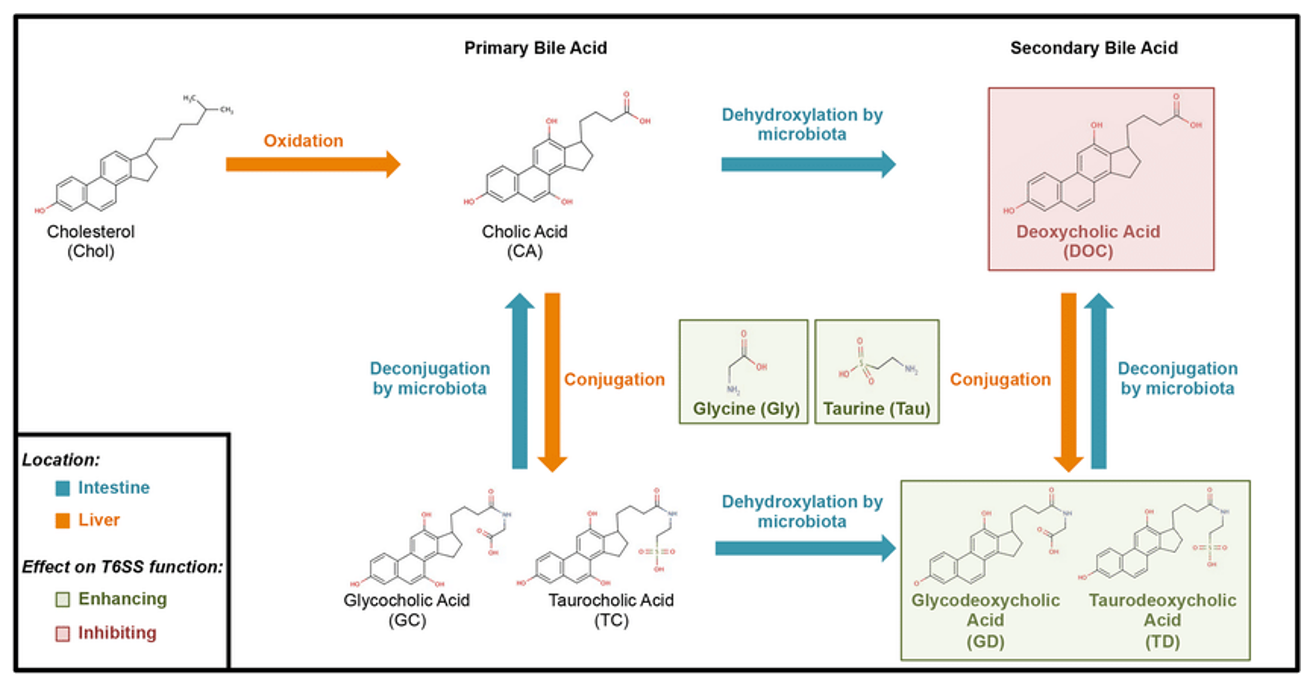The gut microbiota produces a large number of metabolites, such as short-chain fatty acids, bile acids, and indole derivatives. These metabolites send signals through their cognate receptors to regulate the host's metabolism. Cholesterol is oxidized by enzymes in the liver to produce a large number of different bile acids. A large number of microorganisms in the intestine, such as lactic acid bacteria, bifidobacteria, enterobacteria, Bacteroides, Clostridium, etc., further metabolize bile acids to produce secondary bile acids. Changes in the type and content of bile acids can affect the host flora distribution, intestinal barrier function, signal transmission and other biological processes, thereby regulating cholesterol metabolism, glucose homeostasis, insulin sensitivity and other disease phenotypes to a certain extent. In gut microbiota-host co-metabolic diseases, joint analysis is often required between bile acids and the intestinal flora metabolome.
Bile acid metabolism (Bachmann et al., 2015)
CD Genomics uses the LC-MS/MS technology platform to ensure the separation of a variety of bile acid isomers. Bile acids labeled with various isotopes can be used as internal standards to accurately quantify the bile acids in multiple species and biological samples to meet different detection requirements. In addition, we can also implement one-stop, personalized data analysis to help you achieve better data interpretation.
What We Can Provide
Below is a partial list of bile acids that we can detect. If you want to detect other metabolites that are not in the list, you can contact us.
| Cholic acid | 3β-Cholic Acid | Dehydrocholic acid | Allocholic acid |
| Apocholic acid | Chenodeoxycholic acid | Deoxycholic acid | Dehydrolithocholic acid |
| Hyocholicacid | Glycocholic acid | Glycochenodeoxycholic acid | Glycodeoxycholic acid |
| Glycodehydrocholic acid | Glycohyocholic acid | Glycohyodeoxycholic acid | Glycolithocholic acid |
| Glycoursodeoxycholic acid | Hyodeoxycholic acid | Isolithocholic acid | Lithocholic acid |
| Taurocholic acid | Taurodeoxycholic acid | Taurolithocholic acid | Ursodeoxycholic acid |
| α-Muricholic acid | β-Muricholic acid | γ-muricholic acid\hyocholic acid | ω-Muricholic acid |
| Allocholic acid | Apocholic acid | Tauro -muricholic acid | Taurohyocholic acid |
| 12-ketolithocholic acid | 3-dehydrocholic acid | 6,7-diketolithocholic acid | 7-ketodeoxycholic acid |
| 7-Ketolithocholic acid |
Advantages of Bile Acid Analysis Service
- Advanced platform: Ultra-high resolution, ultra-high sensitivity and fast scanning speed QE HF mass spectrometry platform is used for detection, with large throughput and more compound information can be identified. Multiple reaction monitoring (MRM) technology is used to achieve precise qualitative and absolute quantitative.
- High-quality database: The primary and secondary mass spectra in the database are all real spectra detected by the high-quality, high-resolution, high-resolution Orbitrap mass spectrometer using standard products. The compound identification accuracy is high.
- Strict quality control: isotope internal standard calibration, external standard method quantification. Manual proofreading of standards. Standard R2>0.99.
- Personalized service: Have a professional information analysis team to analyze the data results. Personalized information analysis can also be carried out according to customer needs.
Sample Requirements
- Serum and Plasma ≥ 100 µL
- Bile ≥ 100 μL
- Tissue ≥ 50 mg
- Fresh stool ≥ 100 mg
- Cell ≥ 1*107
Duplicate samples:
- Animal samples (various tissues, plasma) ≥10 replicates per group
- Microbial samples ≥ 6 replicates per group
- Cell sample ≥ 3 replicates per group
- Clinical samples (serum, urine, various tissues, etc.) ≥30 cases in each group
Data Analysis
- Raw data
- Data preprocessing
- Data quality control
- Metabolite annotation
Reference
1. Bachmann, Verena, et al. "Bile salts modulate the mucin-activated type VI secretion system of pandemic Vibrio cholerae." PLoS Negl Trop Dis 9.8 (2015): e0004031.
*For Research Use Only. Not for use in diagnostic procedures.


